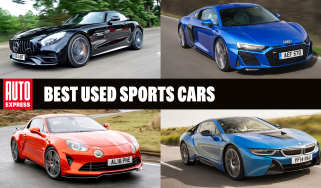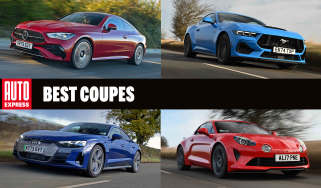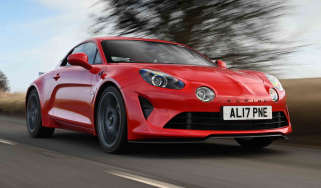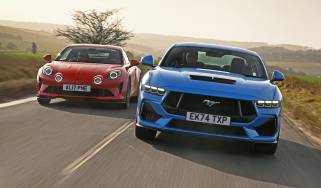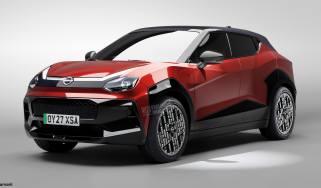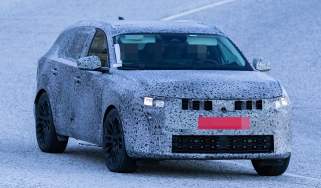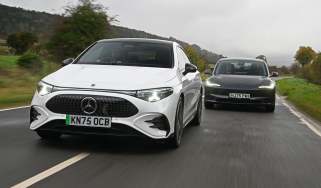The Alpine A110 is going electric and it could have 500bhp
The electric Alpine A110 promises to be a sports car with soul, and our exclusive image previews how it could look
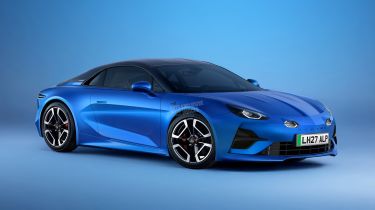
The Alpine A110 is set for a revolution. The replacement for the impressive two-seat coupe is set to get all-electric power, but will still have “soul” and be a worthy rival to Porsche’s upcoming electric Cayman and Boxster, according to a string of Alpine executives.
Alpine’s boss Philippe Krief and former Renault Group CEO Luca de Meo - who has since left to head up the fashion empire at Kering - talked in depth about Alpine’s electric replacement for the A110 coupe, revealing a string of technical headlines.
The electric coupe will ride on a dedicated sports car platform, has a target weight of 1,450kg (close to a Cayman GT4 RS’s), should travel more than 350 miles on a charge, and packs two in-wheel motors that generate “more than enough power – I can guarantee [it],” vows ex-Ferrari director of engineering Krief.
The A110 will be the cornerstone of Renault Group’s attempt to take Alpine’s track pedigree – racing in Formula 1 and the World Endurance Championship – and turn the brand into a thriving, seven-model premium car maker at the cutting edge of new technology. It’s critical that the brand’s low-slung A390 electric SUV – which was unveiled at the brand’s 70th anniversary party in its hometown of Diepp – is a success to start generating the cash the company will need to invest.
If you can’t wait for the new, all-electric Alpine A110, check out our Find a Car service. There you’ll be able to find great deals on a new Alpine A110 or top offers on a used Alpine A110 models. Alternatively we also also have a wide variety of competitive leasing deals.
Before leaving, De Meo’s vision was to create France’s answer to Porsche. “[The A110] is our iconic product, the Porsche 911 of Alpine,” he said. Coincidentally the first A110 coupe – powered by an in-line Renault four-cylinder engine – made its debut in 1963, the same year the 911 was born.
What we know about the electric A110
While the A390 rides on a painstakingly overhauled version of Renault Group’s AmpR-Medium architecture, the coupe will be the first model on the Alpine Performance Platform (APP), and is set to be unveiled at the Paris motor show in October 2026.
“Irrationally, we decided to invest in a very modular sports car platform that will underpin the next-generation A110,” explained de Meo. “The APP is the core of [Alpine]. The priority is to take that platform and develop three or four models, then we'll see what happens.”
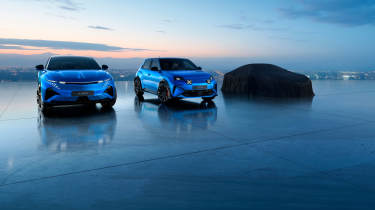
De Meo told Auto Express that APP is a dedicated sports car platform, made from extruded aluminium sections. It will be manufactured in the Dieppe factory, where workers are used to crafting the lightweight alloy.
The material is critical for paring back weight. “We think we can don an electric car that is lighter than a comparable combustion-engine car,” added de Meo. “That will change everything. We’ve invested in the electronic engine architecture, putting the engines in the wheel, [which] lowers the car’s centre of gravity.”
The A110 will finesse the in-wheel motor technology powering the Frankenstein’s monster version of the Renault 5, the Turbo 3E. Alpine’s engineers have converted this outrageous, £135,000 superhatch to rear-wheel drive, with rotors attached to the wheels to spin them. That negates the need for reduction gears and half-shafts, saving weight, and gives huge opportunity to manage torque delivery to individual wheels. While the Turbo 3E will be a drift machine, the new A110 will be set up to carve through corners.
“There will be two motors [on the rear],” says Philippe Krief. “We’ll also have an all-wheel-drive version with two [rear] and one different [front motor] – smaller, lighter.”
And how much combined power will there be, in excess of 500 horsepower? “A lot!” he says. “And we are thinking of evolution also (to give a range of outputs and models). There will be enough power, I can guarantee!”
The motors will be fed by “very high energy density” batteries and an 800-volt electrical architecture, boosting charging capability and enabling thinner wiring and componentry to again reduce weight.
“In terms of motors, you optimise them. Integrate all the functions – motor, transmission, inverter, the DC/DC charger – everything in one box. Then in terms of vehicle integration, you fight for every millimeter you can reduce, every kilo on each single part. I'm not saying that it's easy!” vows Krief.
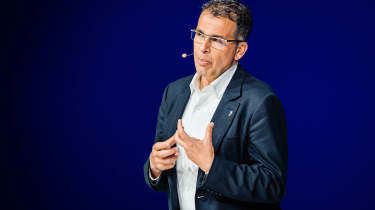
“The weight target of the new A110 is below the best combustion car, a Porsche [718 Cayman],” he confirms. “[It’s] 1.45 [tonnes] to be precise.” Today’s entry-level A110 is extremely petite, stretching to just 4,181mm long and weighing 1,102kg. That means a relatively modest 249bhp four-cylinder engine can fire the coupe from standstill to 62mph in 4.5 seconds.
Batteries, range and driving dynamics
Krief admits the electric coupe will have a slightly bigger frame, but positioning the batteries will be key to keeping the coupe’s height below 1.3 metres – comparable with the current car’s roofline. “We cannot put the battery in the floor because the car will be too high,” Krief tells Auto Express. “So we will put the battery elsewhere and we’ve found some really nice battery installation.
“A big stack is [cost] efficient and if I put my battery in two packs, it will be less efficient. But you definitely could do more than one installation. This is something we can afford because we don't want to trade off on the project: the new A110 has to be a real A110.”
One stack could be placed behind the rear seats in the classic mid-engined position, with the in-wheel motor design freeing up some space. More cells could be located up front but behind the axle line. Weight distribution will dictate the positioning: the A390 five-seat ‘fastback’ has a 49:51 front:rear bias, although its single battery pack lies in the floor.
Krief reckons the electric A110 should be good for a range of 600km (373 miles) – customers won’t accept the “easy” trade-off of a small battery compromising usability. And he believes the switch to electric, with its precise tunability and instant response, will make for an agile-feeling sports car.
“If you give the car a sense of the benefit of [being] electric – quickness in steering and responding, quickness in braking, quickness in recovering from understeer, oversteer – then you have the [lightweight] feeling. In this, electric has a huge advantage, because in terms of response an electric machine is 10 times faster than [a mechanical one].”
Alpine is also experimenting with a sound symposer on the A390, with lower, bassier frequencies in Sport than in regular Daily mode. The soundtrack is generated in real time, based on throttle position, motor speed and other variables, and this thinking is sure to influence the A110 driving experience.
Design
The electric A110 will be true to its forebears in being instantly recognisable, in the same way Porsche design nurtures the 911’s look. “For premium brands, you need a certain consistency, a family feeling,” said former group CEO de Meo. “There will always be some fixed points that are characteristic of Alpine so that you can recognise the products from 200 metres away.”
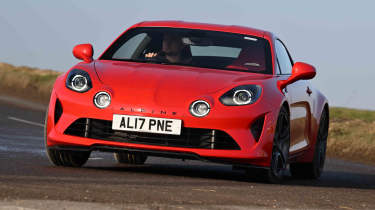
The new A390 fastback displays the common threads of Alpine design, says group vice president Laurens van den Acker. “You have a pointed front end, with Al
pine written in the front and the double-headlight signature. You have the body side line that drops down and the very nice rear window.” Shaped like a helmet’s vizor, it unites the A110 and A390. “But we want to give every car its personality,” van den Acker tells us.
“The A110 will be replaced. If you want the pure DNA of the brand, it’s always available in the A110: it’s the roots on which we’re growing a tree. The A110 will be very recognisable, but in terms of proportions and surfacing, it will evolve – for the better I’d say.”
The APP sports car platform allows for bigger wheels to boost the stance. “And it’s versatile because you cannot make money with one sports car. Because it's extruded aluminum, it’s relatively easy to change the wheel base or width. And that helps pull different vehicles off it,” says the design director. Alpine boss Krief predicts APP will underpin the two-seat coupe and a roadster version, plus 2+2-seater models.
It’s an ambitious plan, which should add a 1,000bhp hybrid supercar and potentially a bigger SUV on top, if Alpine eventually decides to attack the US market. But why will it work, given that French car makers have typically failed to crack the premium market?
Luca de Meo believed the electric transition is a great leveller. “More or less, we are on a par with the others. Everybody's learning, everybody's investing in battery technology and e-motors. It’s not that we have a 100-year gap to close so maybe it’s an opportunity for us.
“In the first generation, electric cars have been, in the main, appliances like washing machines – kind of ugly and unemotional. Maybe we can prove that electric car technology can actually be fun, that we can put in a soul. Alpine’s original position was doing more with less, the use of materials, of lightness instead of a big thing with big batteries. That’s the window I see again.”
Tell us which new car you’re interested in and get the very best offers from our network of over 5,500 UK dealers to compare. Let’s go…
Great used Alpine A110s for sale

2025 Alpine
A110
33,900 milesAutomaticPetrol1.8L
Cash £39,995Find a car with the experts


